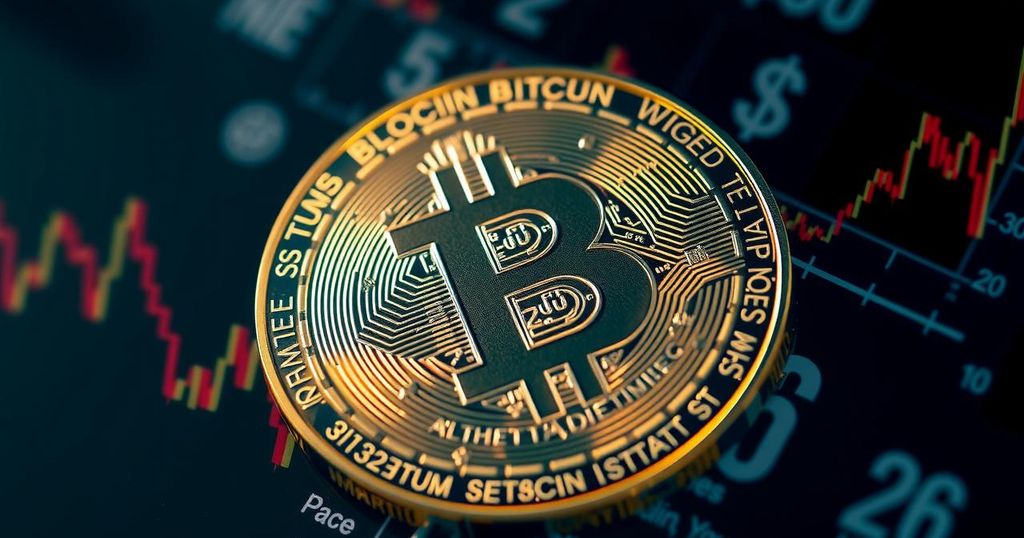Bitcoin Price Faces Pressure Amid Political Uncertainty and Economic Concerns
On Wednesday, Bitcoin’s price fell 0.5% to $67,161.7 amid weakening risk appetite due to U.S. election uncertainties and anticipated smaller interest rate cuts. With Bitcoin struggling to surpass $70,000 and declines in altcoins paralleling its weakness, market volatility is expected to rise as significant options expirations loom.
Bitcoin’s trading price experienced a decline on Wednesday, dropping approximately 0.5% to $67,161.7 as market sentiment towards risk-oriented assets diminished. This drop comes amid growing uncertainty surrounding the upcoming United States presidential election and the anticipation of less aggressive interest rate cuts from the Federal Reserve. The leading cryptocurrency failed to surpass the $70,000 threshold earlier this week, signaling a risk-averse environment among traders. The turbulence in global stock markets further accentuated the waning appetite for risk, prompting speculation of increased volatility in the cryptocurrency markets, particularly with the impending expiration of around $4 billion in Bitcoin options. The current political climate has introduced additional strains as recent polling indicates that Republican nominee Donald Trump may be leading over Democratic candidate Kamala Harris less than two weeks before the election. While initial positive sentiment regarding a potential Trump presidency had provided some support for cryptocurrency values, this optimism appears to be subsiding. It is pertinent to note that Trump has voiced a pro-cryptocurrency stance, suggesting the introduction of crypto-friendly regulations if elected, while Harris has also expressed intentions to establish a coherent regulatory framework for the crypto sector. Furthermore, the cryptocurrency market is under pressure from a strengthening dollar as traders anticipate a more gradual approach to interest rate reductions, which is reflected in a surge in Treasury yields to near a three-month high. Higher interest rates are typically detrimental to speculative assets, such as cryptocurrencies, as they restrict liquidity and investment capacity in the sector. The impact of Bitcoin’s weakness was felt throughout the altcoin market as well, with significant declines in other currencies. For instance, Ethereum (ETH), the second-largest cryptocurrency, decreased by 1.4% to $2,610.01, with expectations of heightened volatility due to the expiration of approximately $1 billion in Ethereum options. Other cryptocurrencies, including XRP, SOL, MATIC, and ADA, also recorded losses ranging from 0.4% to 3%, while prominent meme token Dogecoin (DOGE) dropped by 4.7%.
In recent months, the cryptocurrency market has been experiencing significant volatility, largely influenced by macroeconomic factors such as interest rate decisions and political events. Bitcoin, being the largest cryptocurrency by market capitalization, often sets the tone for the altcoin market. Traders are currently reacting to uncertainties surrounding the 2024 U.S. presidential election and the Federal Reserve’s monetary policy, which collectively contribute to broader market dynamics. The strong correlation between Bitcoin’s movement and the performance of the equity markets has also intensified concerns among investors, particularly in a climate of rising interest rates that negatively impacts speculative asset investments. Understanding these underlying factors is crucial for forecasting potential shifts in market sentiment and pricing.
In summary, Bitcoin’s price decline today reflects a broader trend of risk aversion among investors amid political uncertainty and economic indicators suggesting a cautious approach from the Federal Reserve. As the presidential election approaches, anticipation remains high for shifts in regulatory frameworks regarding cryptocurrencies. The resulting impact is likely to produce heightened volatility in the crypto markets as traders navigate the impending expiration of substantial options, further complicating investment decisions.
Original Source: in.investing.com








Post Comment